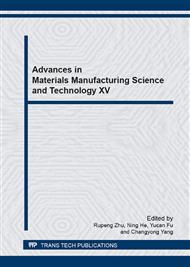[1]
J.Y. Zeng and T.J. Kim: Wear Vol. 193(1996), p.207.
Google Scholar
[2]
J. Wang, D.M. Guo:J. Mater. Process. Technol. Vol. 121 (2/3) (2002) , p.390.
Google Scholar
[3]
E. Capello, M. Monno, Q. Semeraro and P. di Milano: Proc. 12th Conf. Jet Cutting Technol. (1994), p.463.
Google Scholar
[4]
KOVACEVIC R. , HASHISH M. , MOHAN R. , RAMULU M. , KIM T. J. , GESKIN E. S. : J. Manuf. Sci. Eng. Vol. 119 (1997) , p.776.
DOI: 10.1115/1.2836824
Google Scholar
[5]
D. S. Miller: Journal of Materials Processing Technology Vol. 149 (2004), p.37.
Google Scholar
[6]
M. Rahimi, A. Parvareh: Chem Eng J, Vol. 115(2005), p.85.
Google Scholar
[7]
S. Jayanti: Chem Eng Sci, Vol. 56 (2001), p.193.
Google Scholar
[8]
L.W. Adams, M. Barigou: Trans IChem E, Part A, Chem Eng Res Des, Vol. 85 (2007) , p.598.
Google Scholar
[9]
R. Panneerselvam, S. Savithri, G.D. Surender: Chem Eng J, Vol. 132 (2007), p.159.
Google Scholar
[10]
G. Micale, F. Grisafi, L. Rizzuti, etal: Trans IChemE, Part A, Chem Eng Res Des, Vol. 82 (A9)( 2004) , p.1204.
Google Scholar
[11]
H.D. Zughbi, M.A. Rakib: Chem Eng Sci, Vol. 59 (2004) . p.829.
Google Scholar
[12]
W.S. Luo: Fluid properties of micro-abrasive slurry jet and polishing mold steel. PhD Thesis, Guangdong University of Technology, China, (2011).
Google Scholar
[13]
H.T. Liu: The International Journal of Advanced Manufacturing Technology Vol. 32 (2007) , p . 942.
Google Scholar
[14]
M. Zaki, C. Corre, P. Kuszla, etal: International Journal of Material Forming , Vol. 32 (2008), p.1403.
Google Scholar
[15]
R.H. Wang, M.B. Wang: Journal of the University of Petroleum (Natural Science Edition) Vol. 29 (2005), p.46.
Google Scholar
[16]
R.H. Wang, M.B. Wang: Journal of Materials Processing Technology Vol. 210 (2010) , p.190.
Google Scholar
[17]
J.M. Fan, C.Y. Wang, J. Wang : Wear Vol. 266 (2009), p.968.
Google Scholar
[18]
R.G. Hou, C.Z. Huang, J. Wang: Key Engineering Materials Vol. 315-316 (2006) , p.150.
Google Scholar
[19]
J.M. Fan, C.M. Fan, J. Wang: Solid State Phenomena Vol. 175 (2011), p.171.
Google Scholar
[20]
H. Liu, J. Wang, N. A. Kelson: Journal of Materials Processing Technology Vol. 153-154 (2004) , p.488.
Google Scholar
[21]
Wang Rongjuan, Lei Yuyong, Jiang Daijun, etal: Coal Mine Machinery Vol. 32(2011), p.61.
Google Scholar
[22]
W.S. Luo, C.Y. Wang, J. Wang etal: Advanced Materials Research Vol. 325 (2011), p.638.
Google Scholar
[23]
I. M. Hutchings, Tribology. Friction and Wear of Engineering Materials. Edward Arnold, London, (1992).
Google Scholar
[24]
I. Finnie. The mechanism of erosion of ductile metals. Proceedings of the third national congress on applied mechanics, New York, USA, American society of mechanical engineers, 958, 527.
Google Scholar
[25]
I. M. Hutching: Wear Vol. 70 (1981), p.269.
Google Scholar
[26]
R. Brown, E. Jun and J: Wear Vol. 74 (1982), p.143.
Google Scholar
[27]
M. E. Gulden: Wear Vol. 69 (1981), p.115.
Google Scholar
[28]
G. Sundararajan: Trans. Indian Inst. Met., Vol. 36 (6) (1983), p.474.
Google Scholar
[29]
P. Gumbsch and R. M. Cannon: MRS Bull Vol. 25 (5)(2000), p.15.
Google Scholar
[30]
Q. Chen and D. Y. Li: Wear Vol. 254(2003), p.203.
Google Scholar
[31]
J. D. Kim and C. H. Moon: The International Journal of advanced manufacturing technology Vol. 11( 1996), p.319.
Google Scholar
[32]
K. Elalem and D. Y. Li: Journal of Computer-Aided Materials Design Vol. 6 (1999) , p.185.
Google Scholar
[33]
K. Shimizu,T. Noguchi,H. Seitoh,E. Muranaka: Wear Vol. 233-235(1999), p.157.
DOI: 10.1016/s0043-1648(99)00174-x
Google Scholar
[34]
D. Aquaro and E. Fontani: Meccanica Vol. 36(2001), p.651.
Google Scholar
[35]
C.Y. Wang, M.D. Chen, P.X. Yang, etal: Key Engineering Materials Vol. 389-390 (2008), p.381.
Google Scholar


